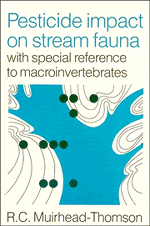Book contents
- Frontmatter
- Contents
- Preface and Acknowledgements
- PART I INTRODUCTION AND ORIGIN OF PESTICIDES IN RUNNING WATERS
- PART II THE ROLE OF LABORATORY AND EXPERIMENTAL METHODS IN EVALUATION
- THREE Laboratory evaluation techniques
- FOUR Artificial community streams and channels in situ
- FIVE Invertebrate reaction to pesticides under laboratory and experimental conditions
- PART III EVALUATION IN PEST CONTROL PROJECTS
- Summary and assessment
- References
- Index
FIVE - Invertebrate reaction to pesticides under laboratory and experimental conditions
Published online by Cambridge University Press: 05 November 2011
- Frontmatter
- Contents
- Preface and Acknowledgements
- PART I INTRODUCTION AND ORIGIN OF PESTICIDES IN RUNNING WATERS
- PART II THE ROLE OF LABORATORY AND EXPERIMENTAL METHODS IN EVALUATION
- THREE Laboratory evaluation techniques
- FOUR Artificial community streams and channels in situ
- FIVE Invertebrate reaction to pesticides under laboratory and experimental conditions
- PART III EVALUATION IN PEST CONTROL PROJECTS
- Summary and assessment
- References
- Index
Summary
TOLERANCE LEVELS UNDER STANDARD CONDITIONS
REACTIONS IN STATIC TESTS
With the widespread use of DDT and allied chlorinated hydrocarbon insecticides for pest control in the 1950s and 1960s it became increasingly clear that stream invertebrates were highly vulnerable to these chemicals. This destructive effect was particularly evident when stream and river habitats were unavoidably contaminated by repeated aerial applications of insecticides against forest pests such as the American spruce budworm. Experiences with mass destruction of river fauna in one of these campaigns in the Yellowstone National Park in the US, stimulated the need for more precise information about the susceptibility of stream invertebrates to the different insecticides then in use. This resulted in perhaps the first serious development of a laboratory evaluation programme for stream invertebrates in general as distinct from such target fauna as Simulium larvae (Gaufin, Jensen & Nelson, 1961; Jensen & Gaufin, 1964, 1966; Gaufin et al., 1965). That and the other contemporary work has already been reviewed in depth (Muirhead-Thomson, 1971), but there are still aspects of those studies which are of particular significance in the light of developments in the 20–25 years since that period. First of all, two aquatic invertebrates which played a prominent part in those laboratory tests, namely the stonefly (Plecoptera) nymphs of Pteronarcys californica and Acroneuria pacifica, were typical of clean unpolluted running water and were also important food organisms of trout. Second, both species were robust creatures, easy to obtain and to maintain in a healthy condition in the laboratory.
- Type
- Chapter
- Information
- Pesticide Impact on Stream FaunaWith Special Reference to Macroinvertebrates, pp. 61 - 116Publisher: Cambridge University PressPrint publication year: 1987

